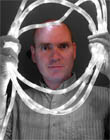|
|
This topic comprises 3 pages: 1 2 3
|
|
Author
|
Topic: Flat/Scope & Super35
|
|
|
John Wilson
Film God

Posts: 5438
From: Sydney, Australia.
Registered: Dec 1999
|
 posted 06-24-2000 04:41 AM
posted 06-24-2000 04:41 AM




Have a search of the archives and look for a topic called 'flat films'. You'll find some reasoning and opinions there.------------------
"I could never be a woman. I'd just sit at home and play with my breasts all day." Steve Martin - L.A. Story
| IP: Logged
|
|
|
|
|
|
Scott Norwood
Film God

Posts: 8146
From: Boston, MA. USA (1774.21 miles northeast of Dallas)
Registered: Jun 99
|
 posted 06-24-2000 06:27 AM
posted 06-24-2000 06:27 AM





Personally, I really like the idea of the 1.5x squeeze ratio for 1.85:1 films (print format only; the camera format would remain the same), but, alas, that will probably never happen, either.
I also think that every screen of every theatre should be properly equipped to show all four common formats: 1.37 flat/Academy, 1.66 European widescreen, 1.85 American Widescreen, and 2.40 CinemaScope, but that won't happen, either...
| IP: Logged
|
|
|
|
John Walsh
Film God

Posts: 2490
From: Connecticut, USA, Earth, Milky Way
Registered: Oct 1999
|
 posted 06-24-2000 08:13 AM
posted 06-24-2000 08:13 AM




Christos has hit on the reasons Super 35 is popular. Some directors do not like the look of anamorphic adapters.I copied this from a posting by a guy (David Mullen) at r.a.m.t. I would like to meet him someday; he seems very knowedgable and is always very clear with explanations; -------------------
"-snip-.....[anamorphic lenses like] Arriscopes, Hawks, Powerscopes, Technovision, Todd-AO, Clairmont, JDC, etc. They all vary in terms of sharpness, speed, distortion, matching, breathing, flaring, minimum focus, etc. You make tests to determine which you want to use.
For example, I know someone who tested the Arriscopes and said they were incredibly sharp (sharper than Hawks) with no flare problems but were also really big & heavy and breathed badly when focused -- while the Hawks flared badly but hardly breathed when focusing."
--------------------- Anyway, the point is that some directors would rather sacrifice grain for the "look" of flat. I don't think this is a *really* bad thing, if other factors are carefully done (copying the negatives, good optical printer lenses when formating for release prints, etc.) Carefully done, film can yeild a very high quality image, even after blowing it up.
Hey, shooting in 65mm would be my choice, but that's not going to happen. I used to really like the idea of release prints with 1.5 squeeze for 1.85. And, it still not a bad idea. But now its just too much work for all the theater. 70mm is already in theaters; why pay to develop and roll out another format? And the theaters are where the image improvement has to be. Maxivision (3 perf format,) Iscovision (1.5 squeeze for 1.85) are good ideas, but are too hard to implement and don't improve the image enough to continue to make film *the* viewing medium for the next 100 years.
| IP: Logged
|
|
|
|
|
|
|
|
Brett Rankin
Film Handler
Posts: 78
From: Sierra Madre, CA
Registered: Jun 99
|
 posted 06-25-2000 01:12 AM
posted 06-25-2000 01:12 AM




Greg,I did find the Saving P. Ryan issue, couldn't track down the Titanic issue though. For the benefit of our beloved readers: From AC, August 1998, Quothe Spielberg: "To me, widescreen formats like CinemaScope were a Hollywood invention of the 1950's. I find widescreen to be an artificial aspect ratio, whereas 1.85 more closely approximates the way the human eye really sees, in the sense that we seeas high to low as we do from side to side. If I hadto make a choice, I'd rather see from high to low. I think the most human perspective is [the range] from 1.66:1 to 1.85:1. The slickest format for theaters is 2.35:1. I've chosen 1.85:1 for my last four pictures because they were intended tobe more lifelike." To each his own, I guess. But I wonder what he means by "slick." Personally, I prefer the look of anamorphic. I don't know what it is but I think it just looks better then super35- depth of field? I dunno. If you compare a couple of DVDs (I admit I bought one) like Mask of Zorro with Mystery Alska, thelatter just LOOKS cropped, and zorro doesn't. What is it exactly between spherical and anamorphic that results in such a different look? I hadn't heard of the 1.5x squeeze before, and what a fantastic idea! That ain't gonna happen, but why not the trailer format? There isn't a single change that would be needed. Thanks all- Brett
| IP: Logged
|
|
Christos Mitsakis
Expert Film Handler

Posts: 242
From: Ag.Paraskevi, ATHENS, GREECE
Registered: Sep 1999
|
 posted 06-25-2000 03:43 AM
posted 06-25-2000 03:43 AM




BrettThe term "depth of field" has nothing to do with screen dimensions. It is related with the focal distance of a certain lens. If you are involved somehow with photography it is easy to understand. By closing the aperture (less light passes through the lens) more area behind - and front from the subject is in focus. On the contrary by opening the aperture only the subject remains sharp and the rest is out of focus.
An anamorphic lens uses many elements (spherical plus anamorphic - cylidrical- adapter), so the light passing through it
is less than a standard lens. Considering this you have to open the aperture (more area out of focus) or put more and stronger light sources to have the same results with a flat lens. C. The Titanic issue of American Cinematographer is Vol.78 No 12, december 1997.
| IP: Logged
|
|
John Wilson
Film God

Posts: 5438
From: Sydney, Australia.
Registered: Dec 1999
|
 posted 06-25-2000 04:00 AM
posted 06-25-2000 04:00 AM




So it seems Steven Spielberg's 'little' films will continue to be 1.85:1. At least he's consistant, I guess. Indiana Jones 4 will be in scope though, thank goodness...can you imagine a 1.85:1 Indy? AAAARRRRRRRRRGGGGGGHHHHHHHHHH.....! Phew!  ------------------
"I could never be a woman. I'd just sit at home and play with my breasts all day." Steve Martin - L.A. Story
| IP: Logged
|
|
|
|
|
|
|
|
All times are Central (GMT -6:00)
|
This topic comprises 3 pages: 1 2 3
|
Powered by Infopop Corporation
UBB.classicTM
6.3.1.2
The Film-Tech Forums are designed for various members related to the cinema industry to express their opinions, viewpoints and testimonials on various products, services and events based upon speculation, personal knowledge and factual information through use, therefore all views represented here allow no liability upon the publishers of this web site and the owners of said views assume no liability for any ill will resulting from these postings. The posts made here are for educational as well as entertainment purposes and as such anyone viewing this portion of the website must accept these views as statements of the author of that opinion
and agrees to release the authors from any and all liability.
|

 Home
Home
 Products
Products
 Store
Store
 Forum
Forum
 Warehouse
Warehouse
 Contact Us
Contact Us




 Printer-friendly view of this topic
Printer-friendly view of this topic




















